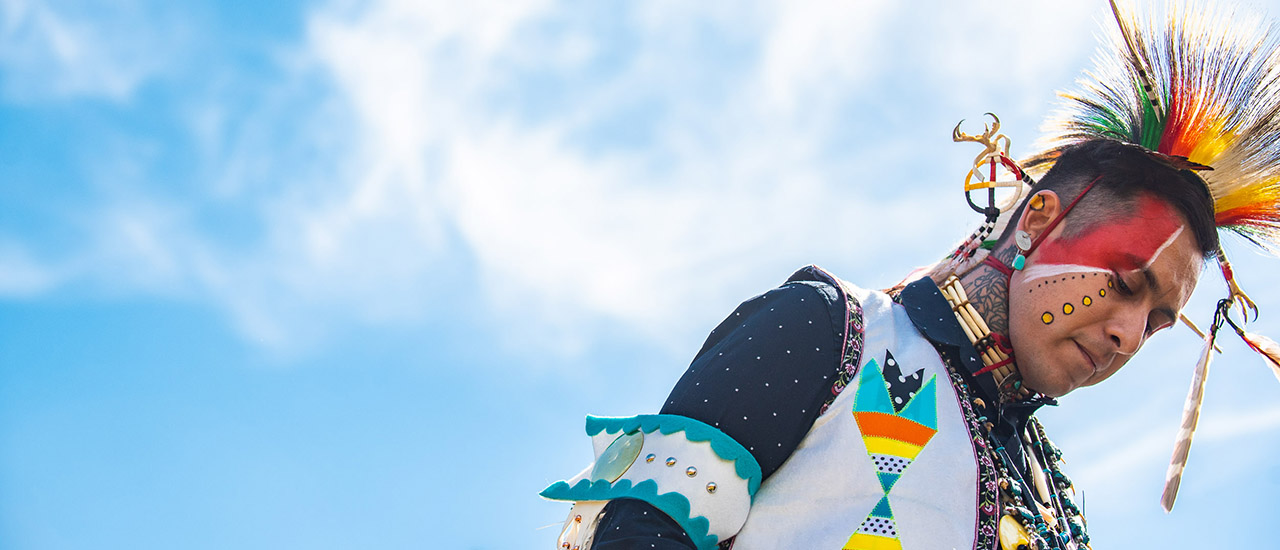
Culture in the Classroom
Craig Stone is director of the American Indian Studies (AIS) program and a professor in the School of Art. He views his dual roles as educating through discovery and artistic creativity, while providing students with knowledge of Native American cultures and their diverse traditions.
When he was hired to teach at Cal State Long Beach, Stone was unlike other professors in the fledgling AIS program that was started in 1968 – the first such program in the country west of the Mississippi. He didn’t have a Ph.D. or lengthy list of published academic articles. Instead, his resume at the time was filled with singing and dancing performances at tribal celebrations and a deep understanding of rituals and art.
“If you are an artist and teaching art, you are expected to produce it, not study it,” Stone said. “So, when they were founding American Indian Studies, they looked at people who were artists making mainstream art about Indian people.
“What I and other artists do is sustain whatever cultural traditions we were taught. The research aspect is actually participating in the world.”
Stone first stepped foot on the Cal State Long Beach campus in 1975 with a group of students from a community college in Riverside, California. He came to take part in the school’s first American Indian Day.

“We came here to sing and dance and explain the culture and celebrate the American Indian presence on campus,” Stone said.
Following the performance, he was recruited to the Cal State Long Beach’s American Indian Studies program and was “excited to learn from our American Indian faculty.” Although the university doesn’t award degrees in American Indian Studies, students can earn a certificate in American Indian and Indigenous Studies or minor in Native American Cultures.
Among the courses Stone teaches is “The Ethnic Experience in the United States,” a class that examines the dynamics of our multicultural society, focusing on the four distinct ethnic groups of American society – Asian American, African American, Mexican American and Native American – and their role in maintaining cultural diversity in the country.
“We touch upon topics such as history, culture and contemporary issues and how many of the disciplines overlap,” Stone said. “We engage dialogue and compare patterns among cultures. Everyone is left knowing that everyone has their own truths and ways of knowing.”

Stone is especially proud of the class he teaches about the annual Pow Wow, which celebrated its 49th year in 2019. The three-day event is held at the center of campus at the sacred site of the ancient Village of Puvunga. It is a gathering place for multiple generations of Native American families wanting to preserve their traditions and reinforce strong bonds within the tribal community.
Stone uses the Pow Wow, with its colorful regalia and sounds, as a teaching tool, helping students learn the history of the tribes that continue to live in Southern California.
Away from the classroom, Stone’s artistic side can be seen around Long Beach, California, in many public spaces. For instance, visitors who stroll down the city’s promenade are shadowed by a flock of stainless steel birds, which are a part of his public art exhibit.Titled “Image Emergence: Promenade of Clouds,” this five-sculpture exhibit is one of many works by Stone, who imbues the landscape of Southern California with subtle artistic enhancements of its sidewalks, parks and public spaces with his artistry.


When he began his artistry in the late 1970s, he examined race, class and gender using various personas to create work that had racial or gender-specific characteristics. Through the project, he realized that everyone is given a certain kind of profile.
“If the art reinforced stereotypes, it was seen as authentic (by critics and art enthusiasts),” Stone said of his earlier work.
He pivoted toward public art, teaching one of the first courses in the United States on the subject for artists. The artist’s work has been funded by both public grants and private donations.
One of Stone’s most prominent pieces is the Hilltop Window Gallery in Signal Hill, California, an exhibit that combines his reverence for American Indian Studies and art. Situated in Hilltop Park, three viewing panels were created through which visitors could enjoy the impressive vistas while learning about the local history of Long Beach and Signal Hill. The panels funnel the viewer’s gaze toward a specific direction in the city and pay homage to the area’s indigenous, agrarian and oil drilling past by providing historical interpretations.

In the center of Hilltop Park, a blue tower installation releases mist reminiscent of the signal fires set by the Tongva Indians, a signal that Spanish explorer Juan Rodríguez Cabrillo chronicled during his expedition of the area in the 1540s.
“The project facilitates your direct observation,” Stone said. “This facilitates the viewing of nature … The intent is to support social interaction.”
Students say that working with Stone changed how they, including Daniela Barbani, see their place in the art world.
“I think he genuinely cares about the students in his class and the work he was making,” said Barbani, a master of fine arts student studying printmaking. “Learning about public art in his class made me realize I don’t see my art living in galleries. I’m all about the community engaging with it. You can’t do that with galleries because only a certain demographic goes to galleries.”
Student Andrea Guerrero said Stone provides guidance while also giving students freedom to explore how and where their art would best be shown. “I think the way he looks at public art as a way of problem solving was really interesting, and something I hadn’t really considered prior to taking his class,” said Guerrero, a master’s student studying art history.
Stone sees his work as creating a bridge between the community, a location and a sense of history. By doing this, he said, “You make the (art) there more visible.”
